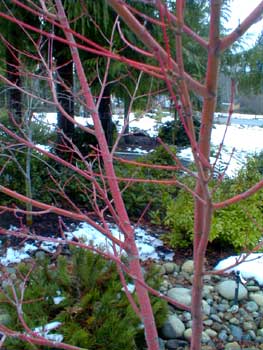
Coral Bark
Japanese Maple
"If you would know strength & patience,
welcome the company of trees."
-Hal Borland
(1900-1978)
(1900-1978)
At a friend's estate where I've done a lot of landscaping, there are three specimens of the upright, vase-shaped Acer palmatum 'Sango-kaku' (formerly 'Senkaki'), the variety famed for its pink bark which is pinkest in winter (see also the Coral Bark page of the Winter Bark Gallery).
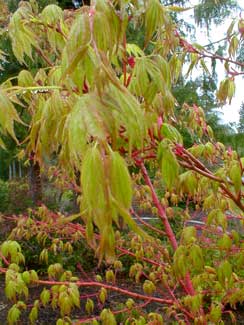 The bark is shown in the first photo in a January photo of the youngest of the three trees. Though slow growing it can eventually be a twenty or twenty-five foot tree; older specimens do not have such extravagantly pink winter bark on their main trunks & main limbs, but young limbs & twigs will continue to provide the color.
The bark is shown in the first photo in a January photo of the youngest of the three trees. Though slow growing it can eventually be a twenty or twenty-five foot tree; older specimens do not have such extravagantly pink winter bark on their main trunks & main limbs, but young limbs & twigs will continue to provide the color.New spring leaves are yellow-green with plum to red edging, palmate but with such deeply cut leaves they are almost ferny. The same young tree is shown in the second photo, in April, with newly emerged leaves not quite having reached their full size. Another coral bark is shown in the third photo, on the same day with newly emerged leaves.
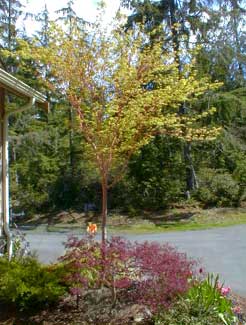 The young leaves age to light green for the rest of spring & then take on autumn-like hues of red & orange beginning in early summer. The fourth photo shows a third coral bark by the driveway in July. The pink-edged orange-reds will become more intense as summer progresses.
The young leaves age to light green for the rest of spring & then take on autumn-like hues of red & orange beginning in early summer. The fourth photo shows a third coral bark by the driveway in July. The pink-edged orange-reds will become more intense as summer progresses.The fifth photo is the smallest of the coral barks (the one seen in the first & second photos) also in July, showing its leaves in darkening summer color, the pinks & oranges intensifying to reds & golds. This smaller tree is shaded by a cedar whereas the larger one by the driveway is in full sun, yet both turn the same summer colors.
Into early autumn the leaves continue their antics as they fade to a ghostly cream before turning peach-colored, or golden yellow with pinkish blush at edges. Some specimens, or in some years, there'll be more of the red-orange or more of the gold-yellow, depending on how soon autumn temperatures drop (see the Coral Bark page of the Autumn Trees Gallery).
In April or May it has small red flowers that turn into winged samaras that reach their full size in summer, & are dispersed late in winter.
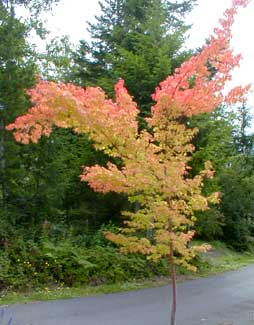 Coral Bark Maple, a recipient of the Award of Garden Merit, prefers partial or bright shade, though on Puget Sound or on the coast it can do just as well in full sun.
Coral Bark Maple, a recipient of the Award of Garden Merit, prefers partial or bright shade, though on Puget Sound or on the coast it can do just as well in full sun.Inland it might also do fairly well in full sun, but that's not its first choice, & for winter in exposed areas it can be harmed by desicating winds. Although not fussy as to soil conditions, rich acid soil induces the best leaf & bark colors.
The coral-bark is ideal for zones 7 & 8, being sensitive in hotter areas, & prone to limb die-back in really cold zones.
It can be a bit brittler than most Japanese maple cultivars, especially when it is young, & it is not uncommon to see them with broken limbs. The youngest of the two coral-barks shown here has lost one of its three main branchings of the trunk, throwing it off balance visually compared to the better vase-shape of the older one.
Saplings grow relatively fast, but they slow down to a slow growth rate after they reach six or seven feet, & should become less & less prone to brittle breakage once they are gaining some rugged thickness to the main branches.
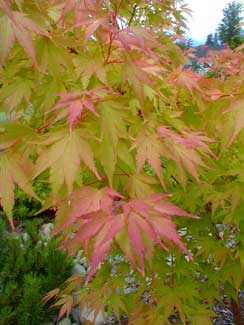 Prune for appearance late autumn or winter. Minor pruning to remove the occasional crossed limb can be done well into spring. If a mature tree is already well-formed, serious pruning may never be required.
Prune for appearance late autumn or winter. Minor pruning to remove the occasional crossed limb can be done well into spring. If a mature tree is already well-formed, serious pruning may never be required.Its Japanese name refers to a specific sea coral. 'Sango' is the Okinawan word for sea coral & "Sango coral" is believed by many to have magical healing properties, so is ingested in powdered form, or water is filtered through it to take in its magical properties.
Profiteers, to give this old superstition a pseudo-medical context, have claimed it is legitimately proven folk-knowledge that Sango coral contains a type of calcium that is better than other calcium sources for the body, the uniqueness of which cures or prevents Alzheimers, bone disease, diabetes, cancer, lupus, & all other digenerative diseases.
Outside of infomercials which the Federal Trade Commission forced to be removed from the airwaves, these claims have no substance. It has no value beyond that of more affordable calcium, & is in fact made up of the hardest calcium for the body to absorb.
The easiest calciums for the body to process are calcium citrate & calcium gluconate; but coral consists of calcium carbonate which is like trying to get one's calcium from eating oyster or clam shells (which some of the same sorts of flimflam artists will tell you can be done, as they offer you jars of ground up seashells of no actual worth). So as it turns out Sango coral calcium is likely the cruddiest rather than the best calcium in the marketplace.
Nevertheless, though claims for coral calcium range from hoaxes & quackery to at best extreme exaggeration, when this name of Okinawan coral was used for the coral-bark maple, it was to imply that if this maple were a coral, then it would be the best of all corals.
The second part of the name, Kaku, literally means "rising upward," but the intent of the name Sango-kaku is to convey the meaning "Coral Tower" or "Coral Pillar," the branches reaching upward as from an actual coral reef.